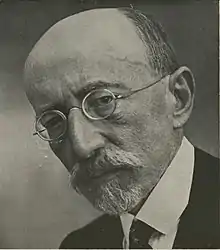Jewish secularism
Jewish secularism refers to secularism in a particularly Jewish context, denoting most often the definition of Jewishness without recourse to religion.[1] Jewish Secularist ideologies first arose in the latter third of the 19th century, and reached the apogee of their influence in the interwar period.

History
The Jews and secularisation
| Part of a series on |
| Jews and Judaism |
|---|
 |
|
The Marranos in Spain, who retained some sense of Jewish identity and alienation while formally Catholic, anticipated the European secularisation process to some degree. Their diaspora outside Iberia united believing Catholics, returnees to Judaism (on both accounts, rarely fully at comfort in their religions) and deists in one "Marrano nation."[2] Spinoza, the herald of the secular age, advocated the demise of religious control over society and the delegation of faith to the private sphere. Yet his notions lacked anything specifically Jewish: He believed that without the ceremonial law to define the Jews, their collective existence would eventually cease, an outcome he regarded as welcome. There is no evidence he retained a sense of Jewishness after being anathemised in 1656.[3] Religious laxity and acculturation, widespread among Spanish exiles, began to appear among the Ashkenazim of Central Europe when affluent court Jews entered Christian society.[4]
At the end of the 18th century, Jewish communal autonomy was gradually abolished by the rising centralised states of Europe, and with it the authority of rabbis and wardens to criminally sanction transgressors. Acculturation, piecemeal integration and, far less importantly, Enlightenment thought, all rapidly chafed at traditional observance. With the weakening of Christianity, the Jews' traditional role as humiliated witnesses to its truth was no longer a political maxim, and the absolutist rulers pondered how to turn them into useful subjects. Jewish intellectuals, members of a new non-rabbinic secularized elite, likewise attempted to solve the modern problems. Radical Jewish enlighteners like Saul Ascher, Lazarus Bendavid and Perez Peter Beer suggested that Judaism be reduced to little more than Deism. Yet even their arguments were predicated on the concept of divine revelation,[5] aiming to restore the religion to an ancient, "pure" version, before God's commandments were supposedly corrupted by irrational additions.
Eventually, the constraints of emancipation in Central and Western Europe, willing to tolerate the Jews as a Christian-like denomination and rejecting any vestige of corporate autonomy, ensured that modernisation and secularisation were expressed in confessionalising Judaism. It was limited to the private sphere, while the Jews were expected to conform to civil norms in the public one, and identify with the nation-state in the political, often as "citizens of the Mosaic faith". The synagogue, family life and strictly religious questions – the differentiation between "secular" and "religious" spheres, imported from Christianity, was alien to Jewish tradition – were the only venues in which Jewishness could be expressed. The nascent Reform movement radically altered the religion so it could be adapted to modern circumstances. The traditionalists, coalescing into self-aware Orthodoxy, silently tolerated change while turning a blind eye to unprincipled laxity. In modernist Orthodox circles, acculturation was even lauded.
The scholars of the "Science of Judaism", who introduced critical academic methods in the study of Jewish history, rebutted traditional interpretation, but were rarely interested in alternatives for the secularized, modern Jews. They even scorned the efforts of religious reform, whether radical or conservative, and many were convinced that Judaism was destined to dissipate; Moritz Steinschneider once commented that their aim was to "duly bury the corpse of Judaism." Utter religious apathy was common among 19th-century Jews, but it was not accompanied by any positive Jewish identity. The children of such people often converted to Christianity.[6]
The rise and heyday of Jewish secularism
Only in late-19th century Eastern Europe, did a new, positive and secular definition of Jewish existence arise. Eastern European Jews, more than 90% of world Jewry at the time, were decidedly unacculturated: In 1897, 97% declared Yiddish their mother tongue and only 26% could read the Russian alphabet. Hebrew remained the language of letters, and traditional education was the norm; out of 5.2 million Jews, only 21,308 attended state schools in 1880. Suffering severe discrimination, they remained a distinct corporate and ethnic group. Secularisation processes were slow: Radical enlighteners, preaching civic integration and modernisation, had to contend with a well-entrenched rabbinic leadership which enjoyed little questioned prestige. Unlike their emancipated brethren in the West, their Jewishness was self-evident and unreflective. On that "thick" layer of ethnicity, with virtually no alternative high culture to assimilate into, the slow disintegration of community life and exposure to modern notions allowed an adaptation, rather than marginalisation. In the 1870's and 1880's, several Jewish national movements coalesced in Eastern Europe, coupled with a literary renaissance of Hebrew and Yiddish. In tandem, young intellectuals advanced a radically new understanding of Jewish identity.
The most prominent of these, who is widely considered as the father of Jewish secularism, was Asher Hirsch Ginsberg, known by his nom de plume Ahad Ha'am. Unlike other thinkers exposed to the influences of secularisation, he did not seek to avoid their implications, but to confront them while maintaining full continuity with the Jewish past. He understood that the theological discourse which defined the Jews was about to lose relevance, first for the young and educated and later for most. While others ignored the subject, Ginsberg delineated a revolutionary solution, borrowing especially from the social Darwinism of Herbert Spencer. He utterly disposed of the question of revelation, which so concerned the Orthodox and Reform in the west, and that of divine election. In his secular, agnostic view, the people arose by itself, not by God's intervention; the driving, enlivening force of Jewish history was not the transmission of God's teachings through the generations, but the creative instincts and "national spirit" of the Jews. He described himself and his like-minded in 1898: The free-thinking Jew, who loves his own people, is a nationalist pantheist. He sees the creativity of the national spirit from within, where the believer only sees a higher power intervening from without.
Ahad Ha'am was not the only one, and far from the most radical, to promulgate a cultural-national conception of Jewishness. His harsh critic Micha Josef Berdyczewski, strongly influenced by Nietzsche, sought a transvaluation of values and preached for a rupture with the past. Ginsberg greatly valued tradition, regarding it not as a body of divine commandments standing in their own right, but as a set of customs aimed at consolidating the people, which could be adapted or abandoned based on that same consideration (this instrumental view of Jewish law was adopted by many secularist ideologists, and even taught as historically factual). Simon Dubnow, yet another leading intellectual of the cultural-national school, was particularly influential in developing a secular Jewish historiography. "Science of Judaism" scholars in Germany, mainly Heinrich Graetz, secularized the rabbinic view of the past, but maintained a religion-based view of it. In Dubnow's work, serving as the basis for all secularist historians, the Jewish people were a "psychological organism", with every individual but "a cell" therein, which was imbued with the primordial instinct to form collective institutions. Dubnow and his supporters espoused national personal autonomy for the Jews in Russia. Yet another thinker, whose philosophy was more explicitly concerned only with Eastern European Jews, was Chaim Zhitlowsky, the founder of radical Yiddishism. With the demise of faith, Zhitlowsky advocated that a monolingustic Yiddish nation and culture were the future of local Jews, with old traditions serving as folklore to be selectively adopted. Neither he nor his followers ever discussed other Jewish ethnic groups.
Ahad Ha'am, Berdyczewski, Dubnow and Zhitlowsky were only few of the most prominent Jewish secularist ideologues of their age. Hundreds of others, influenced by the major thinkers and supporting the various nationalist movements, were active among the millions in the Pale of Settlement, Poland and the adjacent regions.
See also
References
- Not to be confused with the epithet "secular Jew", which has various meanings in different contexts. A "secular Jew" may be a religious Jew who espouses secularism in a general context (in the 20th century, American rabbis who endorsed strict separation of church and state were the most prominent example of "secular Jews"). Broadly, it may denote any Jew who partakes in secular life and is not extremely religious. See: Bullivant, Stephen; Ruse, Michael (eds.). The Oxford Handbook of Atheism. Oxford University Press, 2017. pp. 320-321.
- Yirmiyahu Yovel, The Other Within — The Marranos: Split Identity and Emerging Modernity, Princeton University Press, 2009. pp. 352-358.
- Steven Nadler, A Book Forged in Hell: Spinoza's Scandalous Treatise and the Birth of the Secular Age, Princeton University Press, 2011. pp. 166-168.
- Feiner, Shmuel. The Origins of Jewish Secularization in Eighteenth-Century Europe. University of Pennsylvania Press, 2011. pp. xi–xiii.
- Alan T. Levenson, Roger C. Klein, An Introduction to Modern Jewish Thinkers: From Spinoza to Soloveitchik, Rowman & Littlefield, 2006. p. 121.
- Micahel Meyer, The Origins of the Modern Jew: Jewish Identity and European Culture in Germany, 1749-1824. Wayne State University Press, 1979. pp. 115-123; Jonathan D. Sarna, The Rise, Fall, and Rebirth of Secular Judaism, Center for Cultural Judaism, 2007